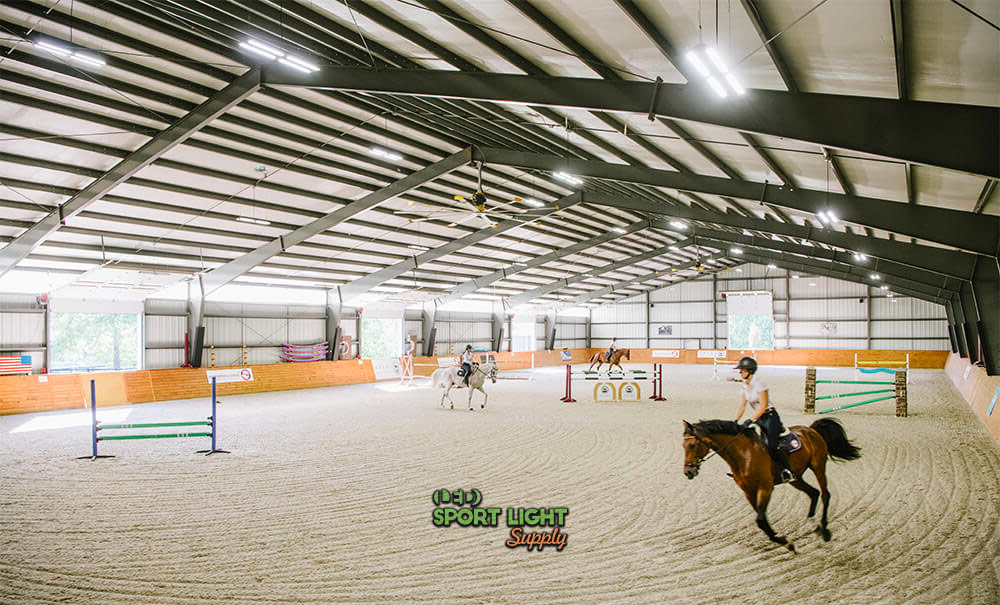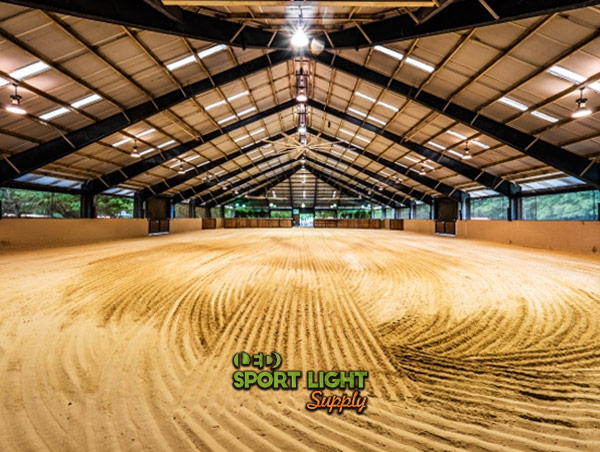Table of Contents
ToggleLux Requirements for Lighting a Riding Arena
The Lux levels required for lighting a riding arena vary based on the level of competition and whether the arena is indoors or outdoors. The following table summarizes the average Lux levels needed from training through to professional competitions. Note that outdoor event Lux levels may be adjusted higher at the discretion of arena owners.
Lux Levels by Competition Level
| Level of Competition | Lux Required (Indoor) | Lux Required (Outdoor) |
|---|---|---|
| Training | 200 to 400 Lux | 100 to 150 Lux |
| Dressage / Intermediate Competition | 300 to 550 Lux | 200 to 300 Lux |
| Professional Show Jumping | 500 to 700 Lux | 500 Lux |
Training
| Arena Type | Activity | Lux Required (Indoor) | Lux Required (Outdoor) |
|---|---|---|---|
| Indoor | Dressage Training | 200 Lux | – |
| Indoor | Show Jumping | 400 Lux | – |
| Outdoor | Dressage Training | – | 100 Lux |
| Outdoor | Show Jumping | – | 150 Lux |
Intermediate Competition
| Arena Type | Activity | Lux Required (Indoor) | Lux Required (Outdoor) |
|---|---|---|---|
| Indoor | Dressage | 300 Lux | – |
| Indoor | Show Jumping | 550 Lux | – |
| Outdoor | Dressage | – | 200 Lux |
| Outdoor | Show Jumping | – | 300 Lux |
Top Level Competitions
| Arena Type | Activity | Lux Required (Indoor) | Lux Required (Outdoor) |
|---|---|---|---|
| Indoor | Dressage | 500 Lux | – |
| Indoor | Show Jumping | 700 Lux | – |
| Outdoor | Dressage | – | 500 Lux |
| Outdoor | Show Jumping | – | 500 Lux |

Lumens Required to Light a Horse Arena
Lumens are calculated by multiplying Lux by the area in square meters. For every 100 square meters, the amount of Lumens needed for the riding arena can be determined using a formula. For example, if the Lux level required is 200 Lux, you would calculate the Lumens as follows:
200 Lux × 100 square meters × 1.2 (to account for light loss) = 24,000 Lumens.
This light loss factor accounts for the height of high mast poles and their distance from the arena.
Although the amount of light loss may be minimal, this adjustment is necessary for larger outdoor horse arenas. For indoor arenas, light loss is generally less of a concern since the lights are positioned facing downward. However, the total size of the arena should still be considered, and adjustments may be needed for higher ceilings to ensure that Lumens are evenly distributed across the floor.
For outdoor arenas, where lights are angled, it is crucial to ensure that the Lux level is evenly distributed to avoid creating hot spots. Hot spots can result from improperly overlapping corner lights or sidelights with higher Lumen output.
Wattage Required to Light a Riding Horse Arena
To estimate the wattage required for lighting a horse arena, you need to consider the Lumens needed and the efficiency of the lighting system. Here’s a step-by-step calculation and additional details on selecting the right LED fixtures.
Wattage Calculation
To calculate the wattage required, use the following information:
| Factor | Value |
|---|---|
| Lumens Required | 24,000 Lumens |
| Lumens per Watt | 150 Lumens/Watt |
| Calculated Wattage | 160 Watts |
Selecting the Right LED Fixture
| Aspect | Description |
|---|---|
| Fixture Wattage | Choose an LED light fixture that meets the calculated wattage of 160 Watts. |
| Dimming Control | Fixtures with dimming options allow adjustment of light levels for practice sessions or specific needs. |
| Outdoor Adjustment | Increase light levels as daylight fades to maintain adequate illumination. |
| Smartphone Control | Some systems offer smartphone apps for easy adjustment of light levels. |
By using these guidelines, you can ensure you select an appropriate LED fixture that meets the lighting requirements of your horse arena while also providing flexibility in light control.
Determining the Lux Required for Lighting a Horse Arena

Level of Competition
The lux levels required for lighting a horse arena vary significantly based on the level of competition. Practice lighting generally does not need to be as intense as competition lighting. Competitions are categorized into intermediate and upper levels, with intermediate events often being regional or local exhibitions, while upper-level events include national and international competitions.
The lighting in upper-level arenas is typically more intense than in intermediate arenas. This is primarily to enhance visibility and improve conditions for both the horses and the audience. Adequate lighting is crucial for capturing high-quality images and videos, especially when TV cameras are used. Slow-motion cameras require additional light to ensure that the footage is clear and detailed. Furthermore, judges need sufficient lighting to accurately assess the horses’ performance, including their purity and agility.
Horse Arena Owners’ Preferences
Preferences for arena lighting can vary widely among horse arena owners. Some owners may prefer brighter lighting, while others may opt for dimmer settings. This choice often depends on the intended use of the arena and the available budget. For training purposes, there is no fixed lux level; rather, it is about what works best for the trainer and the horses.
Having adjustable lighting with a dimmer can be advantageous for training, as it allows for flexibility in lighting conditions. This feature also enables trainers to simulate the higher lighting levels used in professional competitions, which can help horses become accustomed to different lighting environments. By gradually adjusting the lighting, horses can be conditioned to handle various levels of brightness, reducing their sensitivity to changes and ensuring they remain calm under more intense lighting conditions.
Determining the Lumens and Watts for Riding Arena Lighting Fixtures
Light Source
The type of light source used in a riding arena significantly affects both the lumens and watts required for adequate lighting. Traditional lighting options such as metal halide, mercury vapor, and halogen lights generally require higher wattages because of their lower luminous efficiency. These older technologies not only increase the overall cost of lighting but also involve additional operational considerations.
Traditional lights have a longer warm-up time, averaging around 20 minutes to reach peak brightness, which can be inconvenient for practice or semi-professional arenas. Additionally, these lights cannot be restarted immediately and require a cooling period of approximately 30 minutes, followed by another 20 minutes to regain maximum brightness. This can disrupt schedules and complicate lighting management.
Ceiling Height or Pole Height
The height at which lights are installed directly impacts the amount of lumens required. Higher installation heights result in increased light loss, necessitating higher lumen outputs to compensate for this loss. For large outdoor arenas designed for professional events, taller poles are needed to accommodate more spectators and ensure adequate visibility.
Calculations should be performed to account for light loss due to height, ensuring that the arena is adequately lit for the type of event being held. Professional-grade lighting requires precise adjustment to compensate for light loss, ensuring that the light levels remain appropriate and effective.
Beam Angle of Arena Lights
The beam angle of floodlights plays a crucial role in determining the necessary wattage and lumens. Floodlights with larger beam angles, such as 90 degrees, require higher wattages due to the divergence of the light beam. This applies to both indoor and outdoor lighting needs. For high ceilings, larger beam angles are often used to blend lights with neighboring fixtures. However, if a fixture has a poorly designed reflector, stray light may result, causing inefficiencies and potential glare issues.
For high ceilings, narrow beam angles are preferred to ensure proper light distribution and avoid light bleeding outside the intended area. Using floodlights with wide angles on tall poles can exacerbate glare and contribute to light pollution. A light analysis is recommended to determine the most effective beam angles and ensure optimal lux and lumen levels for the arena.
Conclusion
Choosing the correct lighting levels for a horse arena involves several factors including light source, installation height, and beam angle. While traditional lighting methods involve higher wattages and operational challenges, LED lighting provides a more efficient and cost-effective solution. LEDs offer reduced wattage requirements, lower overall costs, and longer lifespans compared to traditional fixtures.
For a precise evaluation of your lighting needs, a free DIALux lighting analysis is available. This 3D simulation helps visualize and optimize lighting conditions for both indoor and outdoor arenas, ensuring the best possible lighting setup for your venue.
